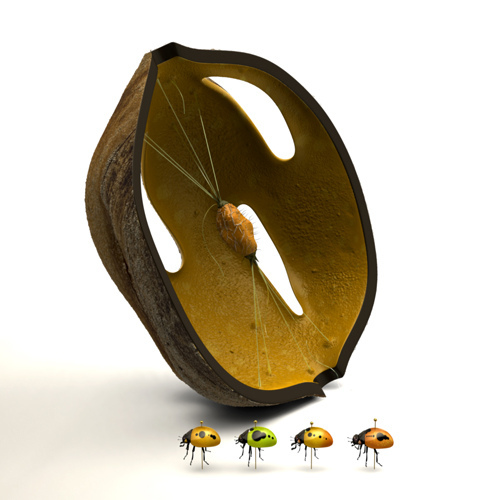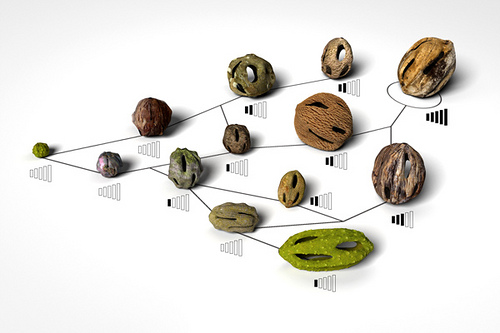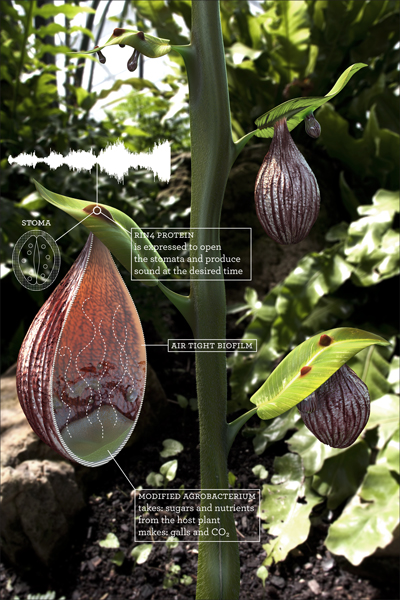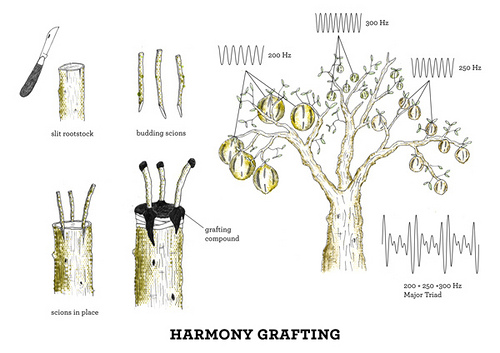Outside looks at the idea of “acoustic sanctuaries” in the sea, designed to help marine life communicate free of “anthropogenic noise,” whether created by military sonar or commercial shipping. Meanwhile, how much would I love to visit an “acoustic sanctuary” on land—a landscape deliberately cleared of “anthropogenic noise”—almost like the sound gardens and acoustic forestry of a designer like David Benqué.
Tag: David Benqué
Acoustic Forestry
 [Image: From Acoustic Botany by David Benqué].
[Image: From Acoustic Botany by David Benqué].
We saw David Benqué’s Fabulous Fabbers project here on BLDGBLOG a few months ago, but his more recent work, Acoustic Botany, deserves similar attention.
Acoustic Botany uses genetically modified plants to produce a “fantastical acoustic garden,” where sounds literally grow on trees. “Desired traits such as volume, timbre and harmony are acquired through selective breeding techniques,” the artist explains.
 [Image: From Acoustic Botany by David Benqué].
[Image: From Acoustic Botany by David Benqué].
As Benqué writes:
The debate around Genetic Engineering is currently centered around vital issues such as food, healthcare and the environment. However, we have been shaping nature for thousands of years, not only to suit our needs, but our most irrational desires. Beautiful flowers, mind altering weeds and crabs shaped like human faces all thrive on these desires, giving them an evolutionary advantage. By presenting a fantastical acoustic garden, a controlled ecosystem of entertainment, I aim to explore our cultural and aesthetic relationship to nature, and to question its future in the age of Synthetic Biology.
There are thus “singing flowers,” “modified agrobacteria” that ingeniously take “sugars and nutrients from the host plant to encourage the growth of parasitic galls and fill them with gas to produce sound,” and “string-nut bugs” that have been “engineered to chew in rhythm” inside hollow gourds.
 [Image: From Acoustic Botany by David Benqué].
[Image: From Acoustic Botany by David Benqué].
The symphonic range of sounds is then fine-tuned and modulated inside an acoustic lab using specialized equipment; out in the field, this takes the form of pruning trees into living chords, so that “harmonic note combinations” can bloom on a single branch.
Upscaling this to the level of all-out acoustic forestry would be an extraordinary thing to hear.
 [Image: From Acoustic Botany by David Benqué].
[Image: From Acoustic Botany by David Benqué].
I’m reminded of at least two quick things here:
1) Several years ago in the excellent British music magazine The Wire, there was an article about Brian Eno and “generative music,” in which the acoustic nature of backyard gardens was described quite beautifully based on the seasonal popping of seedpods, the rustle of leaf-covered fronds in evening breezes, and even, if I remember correctly, the specific insects that such plants might attract and support. Does anyone reading this have experience with planting a backyard garden based on its future acoustics?
2) Alex Metcalf’s Tree Listening project (which I have also covered elsewhere). “The installation,” Metcalf writes, “allows you to listen to the water moving up inside the tree through the Xylem tubes from the roots to the leaves.” Headphones hang down from the tree’s canopy like botanical iPods, and you put them on to lose yourself in arboreal surroundsound. Imagine a shortwave radio that allows you to tune not into distant stations sparkling with disembodied sounds and buzzing voices from the other side of the world, but into the syrupy tides of trees spiked with microphones in forests and sacred groves on every continent.
More images of Benqué’s project can be seen on the artist’s website.
(Spotted on Core77, thanks to a tweet from @soundscrapers).
Fabulous Fabbers
 [Image: The circus tent of infinitely flexible, temporary production, from “Fabulous Fabbers” by David Benqué, produced in collaboration with 3D Mintegration].
[Image: The circus tent of infinitely flexible, temporary production, from “Fabulous Fabbers” by David Benqué, produced in collaboration with 3D Mintegration].
Designer David Benqué‘s “Fabulous Fabbers” project asks what the world might look like if “new techniques to manufacture complex, miniaturised and integrated products, with cheaper and smaller infrastructure than the current silicon industry,” were to become much more widespread, infiltrating our cities, taking over streetscapes, and becoming ineradicable parts of our everyday lives.
 [Image: “Fabulous Fabbers” by David Benqué on display at the Royal College of Art‘s EPSRC IMPACT! Exhibition, April 2010].
[Image: “Fabulous Fabbers” by David Benqué on display at the Royal College of Art‘s EPSRC IMPACT! Exhibition, April 2010].
“The factories are coming to town!” Benqué writes, describing a reverse-migration of productive landscapes back into our homes and cities. Only these aren’t Pittsburghian Satanic mills of large-scale machinery and acre-size factory floors; they are temporary, tiny, and very highly mobile.
That is, Benqué continues, factories “are moving away from the unseen fringes, and into our cities”:
Advances in micro-scale engineering point to a global scale revolution where local, disposable factories produce hi tech goods at our very doorstep. What shapes might this new way of “making things” take within our urban landscape ? From garage-workshops to circus-like temporary structures, from street vendor stalls to vagabond encampments, this project explores the factories of the future and what our relationship to them might be, with the exciting prospect of taking back ownership over our production tools.
 [Image: Rogue Factory from “Fabulous Fabbers” by David Benqué].
[Image: Rogue Factory from “Fabulous Fabbers” by David Benqué].
For instance, there is the Rogue Factory unit producing “custom high-tech goods”—but “what would the black market of ‘special orders’ look like?” Benque asks. This “black market of ‘special orders'” for things like 3D-printed human organs would also be something quite extraordinary to see, given another two decades’ time and cheap-enough bio-ink.

 [Images: More view of “Fabulous Fabbers” by David Benqué].
[Images: More view of “Fabulous Fabbers” by David Benqué].
Benqué’s big-top Mobile Manufacturing Unit, meanwhile, “tours the country, setting up in cities for a few months at a time. As the population welcomes a new source of goods, jobs and manufacturing techniques, it is celebrated as an event.”
 [Image: Mobile Manufacturing Unit by David Benqué].
[Image: Mobile Manufacturing Unit by David Benqué].
There are Self-Replicating Street Stalls and much more in this circusization of street capitalism, post-Fordist productivity fractalizing into every available spatial niche like economic caulk.
 [Image: A Self-Replicating Street Stall by David Benqué].
[Image: A Self-Replicating Street Stall by David Benqué].
In the process, it’s actually quite an interesting question: what architectural forms would flexible, micro-factory-based, socially temporary production really take? Or do the streetscapes of cities as diverse as Lagos and Hong Kong already provide us with an answer to that question?
A while back, we looked street-vendor rights in New York City, courtesy of designer Candy Chang—but what future rights and tools will we see when, say, mobile steel mills roll through the streets of Queens, counterfeit 3D-printing operations park themselves in basements on Canal, or desalination plants on wheels set up shop for three weeks on the SW corner of Nassau and Fulton? How will the 21st century western city be reshaped when it becomes part circus, part factory, part bazaar?
